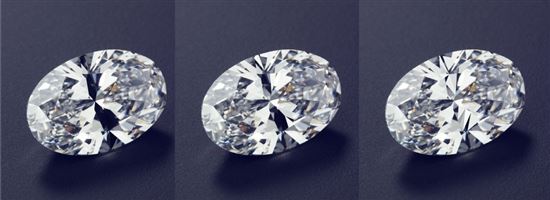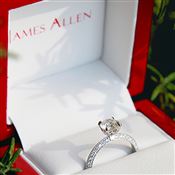Oval Diamond Cheaper Than Round, But Is It Good?
Oval diamonds are brilliant, classy and unique. But this cheaper alternative to round has a big flaw to avoid. Read on to get a perfect oval diamond.
Oval Diamonds Pros and Cons
 |
Why Oval Diamonds Are a Smart Buy
Why do round diamonds get all the fun? Personally, I quite like the more original, yet still sophisticated, look of the oval diamond.
For a twist on the classic round diamond, consider this alternative.
Oval diamonds have a stunning brilliance that demands attention and exudes character. This is a fairly new cut (originating in the 1960s) and is becoming more popular, but it is still unique enough to stand out among the sea of round and princess cut engagement rings.
In this guide, we'll go over some good reasons to consider an oval diamond and tips on how to choose one.
Why You May Like an Oval Diamond
- Cheaper than round diamonds. Oval diamonds are more affordable because they're less in demand. If you're on a budget, they make a beautiful alternative to rounds.
Note: A cut grade is the one big difference between round diamonds and ovals. Since the Gemological Institute (GIA) doesn't have a system for rating fancy cuts (which includes oval), you won't automatically have a take on the stone's brilliance.
A 1-carat oval diamond can be as much as 25%-40% cheaper than a round diamond.
- They look larger than round diamonds too. Because of their elongated shape, oval diamonds often appear larger face-up than round diamonds of the same carat weight. And in fact, many oval diamonds do have a larger surface area.
![Round Diamond Carat Size Chart © CreditDonkey Round Diamond Carat Size Chart]()
Round Diamond Carat Size Chart © CreditDonkey ![Oval Diamond Carat Size Chart © CreditDonkey Oval Diamond Carat Size Chart]()
Oval Diamond Carat Size Chart © CreditDonkey Round diamonds are notorious for having the smallest face-up surface area, but they do shine the brightest.
- But that being said, oval diamonds shine brightly too. Oval diamonds fall under the family of brilliant cut diamonds, which are cuts specifically designed to give off as much fire and sparkle as possible. Oval diamonds are cut the same way as round diamonds, so they're close to round in terms of brilliance.
Tip: Remember, oval diamonds aren't given a cut grade, so you won't be able to know if the one you're looking at is cut well or not. The cut - which includes proportion, symmetry, and polish - determines how light reflects off the diamond. A well-cut diamond will be more beautiful and brilliant.
Here are our suggestions for the best light performance:
- Table Percentage: 54% - 61%
- Depth Percentage: 59% - 64%
- Length to Width Ratio: 1.33 - 1.60
- Girdle Thickness: Very Thin - Slightly Thick
- Cutlet: None
- Symmetry: Very Good - Excellent
- Polish: Very Good - Excellent
We recommend speaking to a trustworthy seller who can tell you if the cut is optimal.
- Table Percentage: 54% - 61%
- Makes the finger appear more slender. Oval diamonds give the illusion of elongated fingers. This style can be especially beautiful on a woman with smaller hands and/or shorter fingers.
- More unique. Round diamonds are no doubt a classic beauty, but an oval diamond has more personality. An oval diamond says "I'm creative and bold and deserve to be set apart." A woman who wears oval is classy, yet at the same time, wants to stand out and express individuality.
Search for Oval Diamonds
Why Oval Cut Diamond Is So Challenging to Buy Right
Now let's go over a couple of things to consider in oval diamonds and how to pick an ideal one.
The Ideal Proportions
Unlike round diamonds (which are always a perfect circle), oval diamonds come in many different shapes. Some are shorter and fatter, and some are longer and skinnier. The final shape is determined from the shape of the rough, so every oval diamond is different.
In our opinion, the most ideal length-to-width ratio is 1.33 - 1.60. But what you choose is really up to personal preference and your idea of an eye-pleasing oval shape. However, be aware of wonky cuts. Some are cut too boxy or too pointed.
Bow Tie
There is one thing to be aware of when choosing an oval diamond shape. And that is that almost every oval diamond will have what's known as the bowtie effect.
A diamond with a large bowtie that blacks out a significant portion of the diamond is undesirable and a sign of bad cut. But having no bowtie doesn't mean it's a perfect oval diamond either (we'll explain in a bit). The trick is to find one where the bowtie meshes in well and doesn't take away from the beauty of the diamond.
 |
The bowtie that you see in the first two diamond images is a dark shadow caused by light blockage. This is a phenomenon that happens in fancy cut diamonds (such as oval, marquise, and pear), due to their shape and uneven distribution of light.
Almost all fancy cut diamonds have some sort of bowtie, so unfortunately, that means it's really hard to find an oval diamond without one. But you can find one with a smaller effect (the 3rd one is minimal to none).
Bowties are easily spotted, so you don't have to wonder if your diamond has one or not. But when shopping for a diamond, there is no way to know unless you're able to see the diamond and spin it around to view all angles.
So if the bowtie is something that bothers you, we suggest that you never buy an oval diamond blind unless you can clearly see photos/video of it.
How to Pick an Oval Diamond
The best oval diamonds are those with maximum brilliance and minimal bowtie. Below are our recommendations for picking the best oval diamond.
Here are some general rules to go by:
- Choosing the right cut. How large the bowtie is all comes down to cut. Better cut diamonds will most likely have a smaller bowtie.
The ideal is to look for a diamond with a depth between 59%-64% percent. Of course, if you're buying blind within this range, it's not absolutely guaranteed that you'll get an oval diamond with very little bowtie. But it can be considered a pretty safe bet.
Diamonds that are too shallow will most likely have a more prominent bowtie (such as this diamond, which only has a depth of 56.6%).
On the other hand, diamonds that are cut too deep (depth percentage larger than 66%) may not show a bowtie at all, but the proportion is not ideal because the brilliance is affected. Not to mention that some of that carat weight is wasted on the deep cut.
Now, after all that, we're going to tell you that in the end, it all comes down to personal preference. A lot of people think that a slight bowtie makes the diamond more unique and distinctive. Sometimes, the contrast between light and shadow could make the diamond appear even brighter. Or maybe the two of you, as a couple, have a silly tradition where she buys you wacky bowties, so a diamond with a bowtie signifies the bond you share.In short, all we're saying is there is no hard right or wrong when it comes to bowties. Some people think they add character and some people insist that there shouldn't be one at all. It simply depends on your personal taste.
- Choose the right color. Oval diamonds tend to trap more yellow tint at the tips. We recommend color H if you're setting the diamond in a white gold or platinum ring. This offers the best balance of price while still looking white.
If you're setting it in a yellow gold or rose gold ring, then you can go down in color. It's safe to go down to a J. These warmer-toned diamonds will beautifully complement the golden band and seem white in comparison.
- Save on clarity. Because ovals are in the brilliant family, they can hide flaws very well. So you can save some money by going with a lower clarity grade. VS2 diamonds will be eye-clean to the naked eye. If you want to save even more, you can go down to SI1.
Bottom Line: A Unique, Cheaper Alternative to Round
If you're looking for something more unique than the traditional round diamond, oval is a great choice. It's elegant and is a shape that will draw attention. We love it for the fact that it sparkles brilliantly, looks bold, and is budget friendly.
Oval will make a great choice for the type of girl who appreciates tradition, but likes to express individuality. And hey, if it's good enough for the Duchess of Cambridge, it's good enough for us.
Write to Anna G at feedback@creditdonkey.com. Follow us on Twitter and Facebook for our latest posts.
Note: This website is made possible through financial relationships with some of the products and services mentioned on this site. We may receive compensation if you shop through links in our content. You do not have to use our links, but you help support CreditDonkey if you do.
|
|
|






